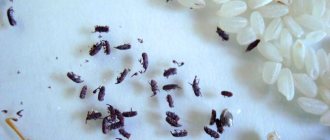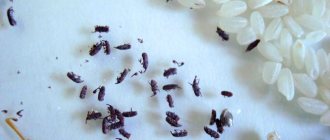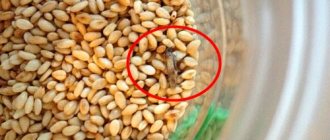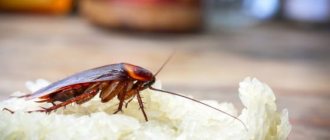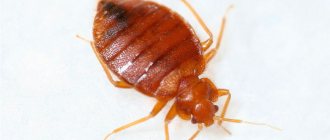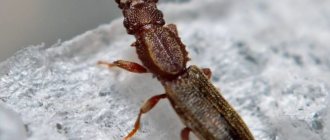The kitchen is the center of attraction of any home. Here they cook, eat, socialize. If unexpectedly bugs from nowhere are discovered in the supply cupboards in the kitchen, housewives get upset.
We have to start fighting small pests, sort through and destroy almost all the products stored on the shelves. These nasty bugs can start in the cleanest kitchen, and you can get rid of them without a trace and quickly enough, before the pest beetles cause significant damage.
Why do bugs appear in the kitchen?
If there are small bugs in the kitchen, you should carefully consider the ways in which they appear in the house.
- Eggs and larvae of insect pests can contaminate unpackaged products purchased in bulk at markets, supermarkets, and wholesale depots where storage conditions are not met.
- Insects can also be found in packages brought from the store, in which low-quality raw materials were packaged from the manufacturer.
- Bugs in the cupboard with cereals can appear from the food products with which they are “neighborhood”. Often the breeding ground for pests are:
- dried fruits;
- loose tea leaves;
- spices and seasonings.
- If the rules for storing groceries at home are not followed:
- increased temperature and humidity;
- unsealed containers;
- excess amount of food purchased for future use.
- Insects can move into grains from wooden furniture or kitchen utensils.
- Come from the neighbors through the ventilation.
From the shop
Is it possible to eat foods that have insects in them?
Is it possible to use flour with bugs? We repeat once again - products can only be used if there is minor contamination. In all other cases, it is better to throw them away - such food will not benefit your body!
See also: find out how to properly store cereals so that bugs and mold do not grow there?
The problem of the appearance of beetles in cereals is relevant. This is due to an unscrupulous attitude towards the saving conditions of producers, since most insects end up in cereals when packaged in factories.
Types of bugs
Bugs in the rump may appear as small black dots. Their larvae resemble small, thick white worms. Pests of stocks in our latitudes are most often several types of insects.
- Brown bugs in cereals such as rice, pearl barley, rolled oats are most likely red mucoeds . Their length is less than a grain of rice - 1.5-2 mm. Capable of flying. Adults do not eat flour and cereals, but lay a countless number of eggs, from which very small larvae hatch, not noticeable in the product due to their white color. So they eat the cereal, spoiling it and making it unsuitable for cooking.
- Suriname flour beetle , flour beetle or small beetle is another brownish-brown bug. Its size is slightly more than 3 mm; characteristic numerous teeth can be seen on the sides of the body. White larvae, about 4 mm long, feed on grains damaged by adults. Flour and cereals in the container collect in lumps and acquire an unpleasant musty smell.
On a note! The Suriname flour beetle is one of the most common beetles that pest bulk food products in the world. Colonies of these beetles often occupy granaries and food production facilities, from where they enter the kitchen. Insects are able to live and feed in dried fruits, cookies, leaf tobacco and even plant-based drugs.
- The bread grinder is a bug up to 4 mm long, dark brown in color. The pests are adults and larvae. Adults do not eat cereals directly, but they drill numerous holes in the products themselves and in the packaging. Like all pests, it multiplies quickly at high temperatures. Lives in bakeries and warehouses.
On a note! In English-speaking countries, the pest is called the pharmaceutical beetle, since the insect larvae are not only very voracious, but also indiscriminate in food. They can eat plant and medicinal materials, including poisonous ones. This species can also harm books (especially old ones), entomological collections, raw silk, herbariums, and collection seeds.
- Occasionally in the kitchen you can find a weevil - a tiny round black bug. The length is no more than 1.5 mm. They live mainly in fields where legume crops are cultivated: beans, peas, etc., and take root well in granaries.
Are bugs in the kitchen dangerous?
If you find that there are bugs or larvae in cereals, for example, semolina, it is too early to panic, but it is worth collecting information about how pests of stocks can be dangerous:
- If not detected in a timely manner, pests can multiply and move from the original source to other food supplies in the house and damage wooden furniture.
- They will not cause serious poisoning to humans, but they can cause digestive upset.
- Waste products of adults and especially larvae can cause allergy attacks, especially in young children.
Is it possible to eat contaminated cereals and flour?
Bugs that appear in the kitchen cabinet indicate that the food has been contaminated. Pest control should be started urgently, as they multiply exponentially. Flour, beans, cereals, tea, spices and other groceries are not suitable for human or pet consumption. You need to get rid of them without regret.
Contaminated products
Methods for getting rid of bugs in the kitchen
Don’t despair if you find pests in food supplies. There are several ways to get rid of bugs in your kitchen cabinets.
First you need to empty your cabinets and closets. Next, check the furniture and shelves for eggs and insect larvae and destroy them.
Folk methods of struggle
You can get rid of bugs that have infested cereals in the kitchen using old, proven methods. Our grandmothers also knew how to get rid of flour bugs in the cupboard quickly and safely.
- The first way to remove bugs from cereals is to place small containers with vegetable oil in the corners of kitchen cabinets. Pests attracted by the smell fall into the oil, which clogs the spiracles (holes through which insects breathe). After some time, the insects die.
- The next thing you can do if there are bugs in the cereal is to place plants with a repulsive odor in the cabinets. Natural repellents are: bay leaf;
- lavender;
- pyrethrum (chamomile);
- sagebrush.
Attention! Remember that sodium tetraborate is poisonous. Do not use poisoned baits where children or pets can reach them.
Chemicals
In stores you can purchase ready-made poisonous compounds that will allow you to fight bugs and get rid of unwanted bugs in your closet forever.
The following drugs are intended to combat them:
- "Antizhuk" is an insecticide for surface treatment.
- “Rogneda” will allow you to get rid of not only cereal bugs, but also cockroaches.
- “Dichlorvos” is an aerosol that allows you to treat crevices and cracks in furniture that can harbor pests.
Dichlorvos
Attention! When using insecticides, take precautions:
- all food must be removed from the kitchen;
- hands, eyes and respiratory organs must be protected with PPE;
- carry out processing without children and pets.
You can treat the cabinet with a chlorine solution, for example, “Belizna”, and the more saturated the solution, the more effective the expected result. After this, it is necessary to ventilate the room.
Chemical methods and store-bought products
Chemical methods can affect people's well-being, so strict adherence to safety precautions is necessary when using them. As a rule, the instructions for use contain information about the period during which you cannot enter the premises.
The store shelves have a huge assortment to suit every taste, color and budget. Here are the most popular options:
You can use Dust, Whiteness and other compounds. If the owner determines the type of beetle, then you can pick up the remedy in any specialized store.
Prevention of bugs
Kitchen bugs will not appear in the kitchen if you follow the rules for purchasing, storing and processing food.
- Buy cereals, flour, grain products, beans, dried fruits, and vegetable raw materials in transparent containers. This will help you take a closer look at the contents of the package. Also make sure that the package is intact.
- Purchased goods can be disinfected at home:
- holding it in direct sunlight (ultraviolet);
- calcined in the oven at a temperature of about +1000C (not suitable for all products);
- low temperatures have a detrimental effect on pests, especially in the egg and larval stages, so it is worth placing them in the freezer for a day.
- Inventory in cupboards and pantries should be checked periodically to identify pests. Particular attention should be paid to products brought from the market: dried fruits, spices, etc.
- Storage containers should be pre-washed with soda solution.
- Shelves and cabinet walls can be treated with a vinegar solution or disinfectant.
- You should not allow an excess of groceries; do not buy for future use.
- It is better to pour store-bought cereals and flour into clean, sealed containers made of glass or plastic.
- It is necessary to maintain optimal temperature and humidity conditions in the kitchen and utility rooms.
- Try not to purchase products that have not passed phytosanitary control.
Most common places
Don’t think that bugs only love tasty things: cereals and sugar.
These are such omnivorous creatures that you can find them anywhere, even in packages (sealed!) with mustard plasters.
And also in spices, including red pepper.
And since they feel great in such a place, you yourself understand that folk remedies that include something burning in their composition will not help you. But, more on that later, for now let’s identify the most likely places of their deployment, since we need to act quickly and surely.
Carefully inspect all bags of cereals. Start looking for nasties in open packages, that’s where they get in most often. If there are a lot of them there, then you can be sure that they have already managed to penetrate into closed ones, you just can’t see them yet, because the holes they gnaw are very small.
Inspect all dry provisions, as they can be not only in cereals, but also in flour, pasta, and sugar.
Maybe they don’t like salt, but look anyway, it won’t hurt. Maybe you have some special salt-eating bugs? It’s better to be on the safe side in this matter, because as soon as you leave their “nest” somewhere, you won’t even have time to blink an eye before they fill the kitchen again.
Beans are the best “house”. Why exactly the bugs love her so much is not very clear, but the fact remains. If beans are not stored in the freezer, but simply in a jar or bag, then sooner or later they will have to be eaten by beetles.
Most likely, it is in the beans that some special bugs appear, the larvae of which were already in it before, they just “sleep” until a certain moment. And as soon as they get into the heat, they immediately begin to turn into bugs, which leave dark, large spots and holes on the grains.
Or maybe some stray parasite gets into the beans from the field and then quickly multiplies? It’s not very clear, but that’s not the point.
Beans are the most vulnerable, so make it a rule to keep them in the freezer.
This is the most ideal storage place. After freezing, the quality of the grain does not change at all and it can even be planted; it germinates perfectly.
Sort through spices and medicines. As we already wrote above, bugs simply adore mustard plasters. Although it’s bitter, it’s still some kind of torment. So, look, are they there? Also, open the packages of patches, tablets and thoroughly wipe the cabinet itself. Maybe they will crawl out when you start rustling in the box. And spices - peppers, seasonings, all kinds of herbs. They could be anywhere!
Tea, coffee, dried fruits are also their favorites. Usually, it is precisely these things that housewives forget most often. They are practically invisible in the bank. They only float up when you pour the drink. This is a very disgusting sight! Therefore, look, otherwise, the hour is uneven, you will embarrass yourself by pouring tea for a guest.
Pay attention to the boxes with vegetables. Imagine, bugs even love onions
There are many posts on forums online where women say that pests have appeared even there. At the same time, the onion deteriorates and becomes soft. Therefore, don’t be lazy and inspect all the vegetables.
Look behind furniture walls and into crevices. Bugs are different. Some are cereal, and some are furniture. They are not particularly interested in provisions, but they are great at cruising around the kitchen, making crap and spoiling the mood with their appearance.
They thrive in kitchen cabinets, feeding on crumbs. In addition to kitchen furniture, open drawers in other rooms. If there are already a lot of them, then they could easily spread throughout the apartment.
Check the window sills. The kitchen window sill is especially vulnerable. Housewives often use it as an additional workplace. Therefore, there may be all sorts of tiny things in the cracks, behind which bugs will stick. And there they will make a “den” for themselves.
Take a good look at the floor. They can also have a great time there. Especially if your floors are wooden and have many small cracks. They are not so easy to spot on the floor. Here you need to either etch them with steam or wipe them with bleach. Then they jump out, and you will already know where to chase them from.
Clean out all household appliances. Surprisingly, bugs even occupy equipment. They can be found in mixers, meat grinders and even irons.
One woman on the forum wrote that she found bugs when she started ironing her blouse. Turn on the steam and they will fall out... Brrr...
So, don't forget to take a look. It will be very disappointing if you start making minced meat and there are bugs in it.
